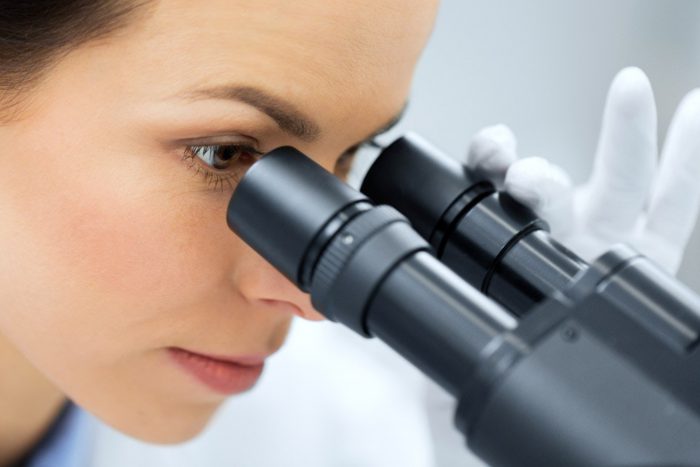
A colposcopy is a type of medical procedure where a doctor uses a colposcope instrument to visually examine a woman’s vulva, cervix, and vagina. The primary purpose of the colposcopy-based examination is to look for signs of cervical cancer or other related diseases in the opening area of a woman’s uterus.
The cervix is part of the lower uterus between the rectum and bladder. It opens a canal into the woman’s vagina from inside to outside her body. The vagina links the vulva to the cervix, allowing menstrual fluids to leave the body.
The naked eye cannot notice the signs of disease without increased magnification. Therefore, doctors use the colposcopy instrument to perform the procedure because it features a light and a magnifying lens to magnify the tissues of the uterus. This magnification allows doctors to see the signs of disease more clearly.
In more severe cases, the doctor will perform a cervical biopsy to remove a tiny tissue from the uterus and examine it in a laboratory more closely. But the colposcopy procedure is usually the first examination performed on new patients with symptoms in their cervical or vaginal areas. A biopsy may or may not be needed, depending on the condition.
Could You Benefit from a Colposcopy?
Your primary healthcare provider may want you to undergo a colposcopy if your pap or pelvic examination results show abnormal cellular growth present. The colposcopy will let your doctor notice visible signs or other noticeable changes to your vaginal, cervical, or vulval tissues. These visible signs may include unusual blood vessels or strange tissue patterns or colors.
Abnormal cellular growth doesn’t mean you have cancer, at least not yet. Instead, it is a precancerous sign to warn you of pending cancer which could develop within the next few years unless you seek immediate treatment. That is why it is better to get your colposcopy done sooner rather than later. If your doctor can spot the abnormal tissue growth early enough, they can advise you on how to deal with it.
A colposcopy allows a doctor to discover, diagnose and treat any of the following symptoms:
- Non-cancerous cellular growth
- Involuntary exposure to diethylstilbestrol
- Abnormal cellular growth
- Vaginal bleeding
- Genital warts
Human papillomavirus (HPV) is one of the leading causes of cervical cancer in women. It is first noticeable by the formation of genital warts on her uterus. And if a woman’s mother consumed the female hormone estrogen medication “diethylstilbestrol” while pregnant, the woman has a greater chance of cancer forming in her reproductive system.
Is the Colposcopy Procedure Safe?
There are some risks associated with the colposcopy procedure. For instance, a small number of female patients may experience bleeding or infection after the procedure. And if you have a sensitivity or allergy to certain medications or ingredients like latex or iodine, disclose this information to your primary healthcare provider. Also, let them know if you’re pregnant or believe you’re pregnant.
You’ll have the chance to discuss all your concerns about the procedure with your doctor before getting it done. Then, when you’re ready to schedule your appointment for the colposcopy, plan for a date about seven days after your last period. That is the best time to get it done.
It may turn out that you won’t even qualify for a colposcopy procedure if you have certain preexisting conditions, such as acute cervical inflammation or acute pelvic inflammation. A standard physical examination will allow your doctor to determine whether you qualify.
Preparing for the Colposcopy
A lot of preparation and planning is done before the colposcopy procedure. Below is a list of the typical steps involved in the preparation process:
1) You’ll consult your physician regarding the colposcopy procedure and ask them any questions you may have about it.
Tell your doctor if you are pregnant, believed to be pregnant, or allergic to certain medications or materials. In addition, tell them what prescription medications, over-the-counter drugs, and supplements you currently take. The doctor definitely needs to know if you take any blood thinning medication or aspirin because they can impact blood clotting.
2) If you agree to undergo the procedure, the doctor will have you sign a consent form first. It is a standard form they require you to sign before doing the colposcopy on you. Make sure you read over the various terms and provisions of the consent form and ask questions if you don’t understand anything. You should only sign after you are clear about what to expect from the procedure.
3) On the days leading up to the scheduled date of the procedure, you don’t have to do any special preparations like fasting. The only exception is if you must go under general or local anesthesia. In that case, you must fast a few hours before the colposcopy.
4) Your doctor will advise you to refrain from taking blood thinning medications or aspirins before the procedure. In fact, you cannot have sex or take any medicines, tampons, or vaginal creams within 24 hours before the procedure.
5) Your doctor may advise you to take a pain reliever medicine about half an hour before the colposcopy procedure begins. Otherwise, the doctor will administer a sedative before giving you the anesthetic. Please ask a friend or family member to drive you home if a sedative has to be administered. Your mind won’t be clear enough to drive home independently after the procedure.
6) Keep a sanitary pad with you on the day of the procedure. You may need to wear it after the procedure is over.
7) Follow any other advice given to you by your doctor.
What Can I Expect During the Colposcopy Procedure
Your colposcopy may be performed in the office of your primary care provider or at a local hospital. It really depends on your current health condition and the skills and abilities of your current doctor. Many primary care physicians will refer you to other doctors who specialize in performing the procedure.
Here are the general steps of the colposcopy process on the day of the procedure:
1) Take off your clothes (at least from below the waist) and put on a hospital gown.
2) Urinate into the toilet to empty your bladder.
3) Lie your back down on the examination table. There will be a support system in place for your feet and legs.
4) The doctor will spread your vaginal walls apart using a special instrument known as a speculum. This allows the doctor to see the cervix more clearly.
5) The doctor will insert the colposcope instrument into the vaginal opening, but without actually going all the way into the vagina.
6) The doctor will look through the magnifying glass of the colposcope to check for irregularities or signs of disease in your vagina or cervix.
7) The doctor may apply a vinegar / acetic acid solution to wash your cervix. Once the solution makes contact with any abnormal tissues in the cervix region, those tissues will become white. It may feel a little burning too.
8) Sometimes, a biopsy is necessary because the doctor may need to remove a small piece of tissue from the cervix area to study more closely in a laboratory. If this needs to happen, the doctor will administer an anesthetic to numb the area before extracting a piece of tissue.
9) The doctor may want to extract a few cells within the cervical canal area. You could feel minor cramping afterward, but it’ll go away quickly.
10) If the doctor performs a biopsy, they will apply a pasty topical solution to minimize the bleeding.
Now you just wait for the laboratory to finish testing the tissue sample.
After the Colposcopy Procedure
There is no long-term recovery needed after the colposcopy procedure. If no biopsy is done, you can usually return home within minutes after the procedure.
However, the recovery time varies when a colposcopy and biopsy are done together. The factors of the recovery time include the type of anesthetic administered and the biopsy type performed.
If you receive a local or general anesthetic before the procedure, the staff will bring you to a recovery room afterward. The doctor or nurse will check your breathing, pulse rate, and blood pressure while in recovery. If the medical professionals confirm they are at stable levels, you will be returned to your hospital room for discharge.
Please have a designated driver available to drive you home after you’re discharged.
The Short-Term Colposcopy Recovery
You may experience bleeding symptoms, so wear a sanitary pad until the bleeding stops. A biopsy will often cause you to experience mild spotting, cramping, and a dark discolored discharge from the medicinal solution put on the cervix to minimize bleeding.
Don’t worry because these symptoms should clear up within days. In the meantime, refrain from having sex or using tampons for at least seven days after the colposcopy. Try not to touch the affected area either. And most importantly, listen to the advice and guidance of your doctor.
The doctor’s standard post-procedure recommendation will be no strenuous activity, such as high-intensity exercise or lifting heavy weights. You also won’t be able to return to your regular diet until your doctor gives their approval.
If you need a pain-relieving medication, your doctor will recommend or prescribe one. Don’t take certain pain medicines known to increase bleeding, such as aspirin. Instead, listen to your doctor’s advice and inform them whenever you experience bleeding, fever, chills, smelly vaginal drainage, or severe pelvic pain. Then, they can continue to advise you on how to deal with these symptoms.






